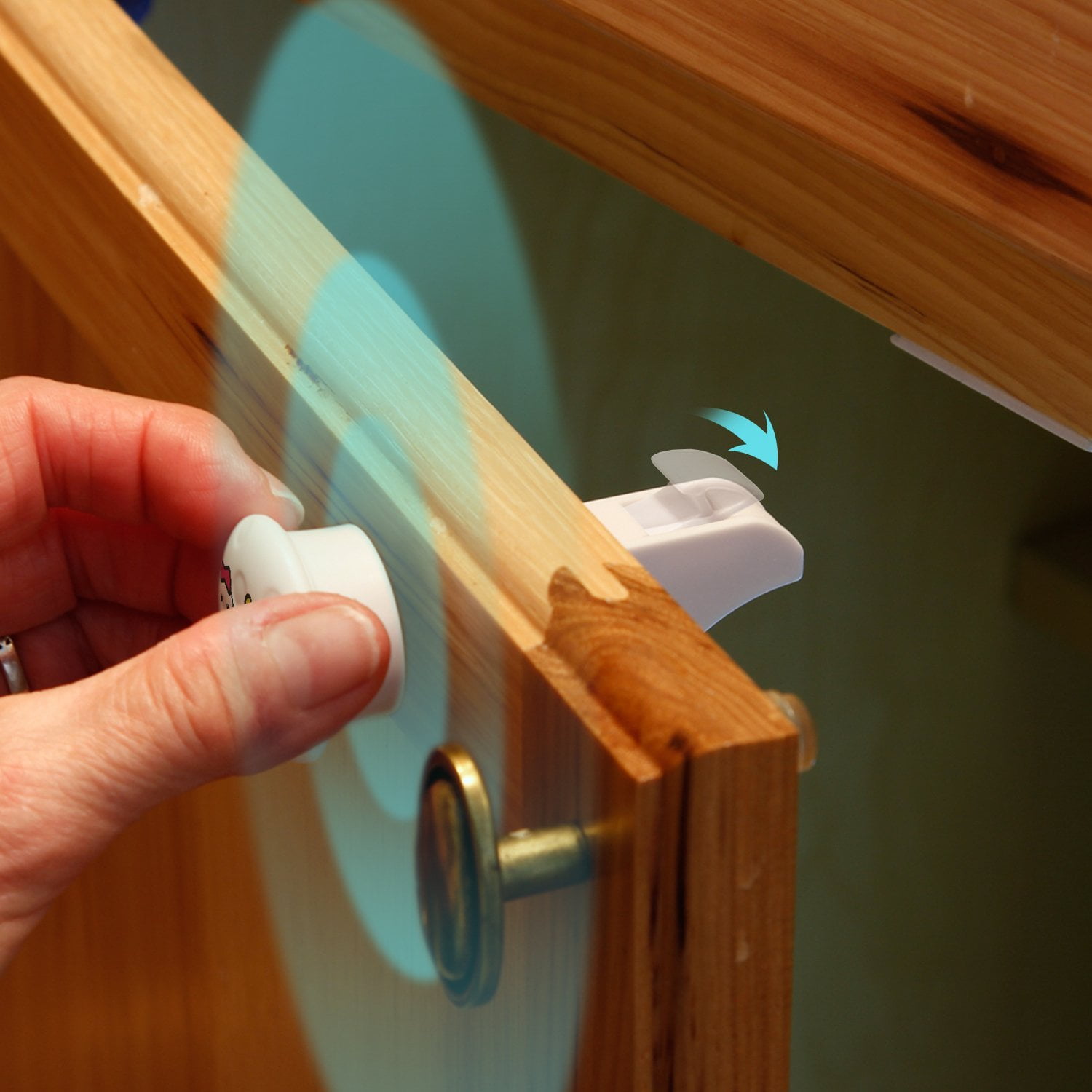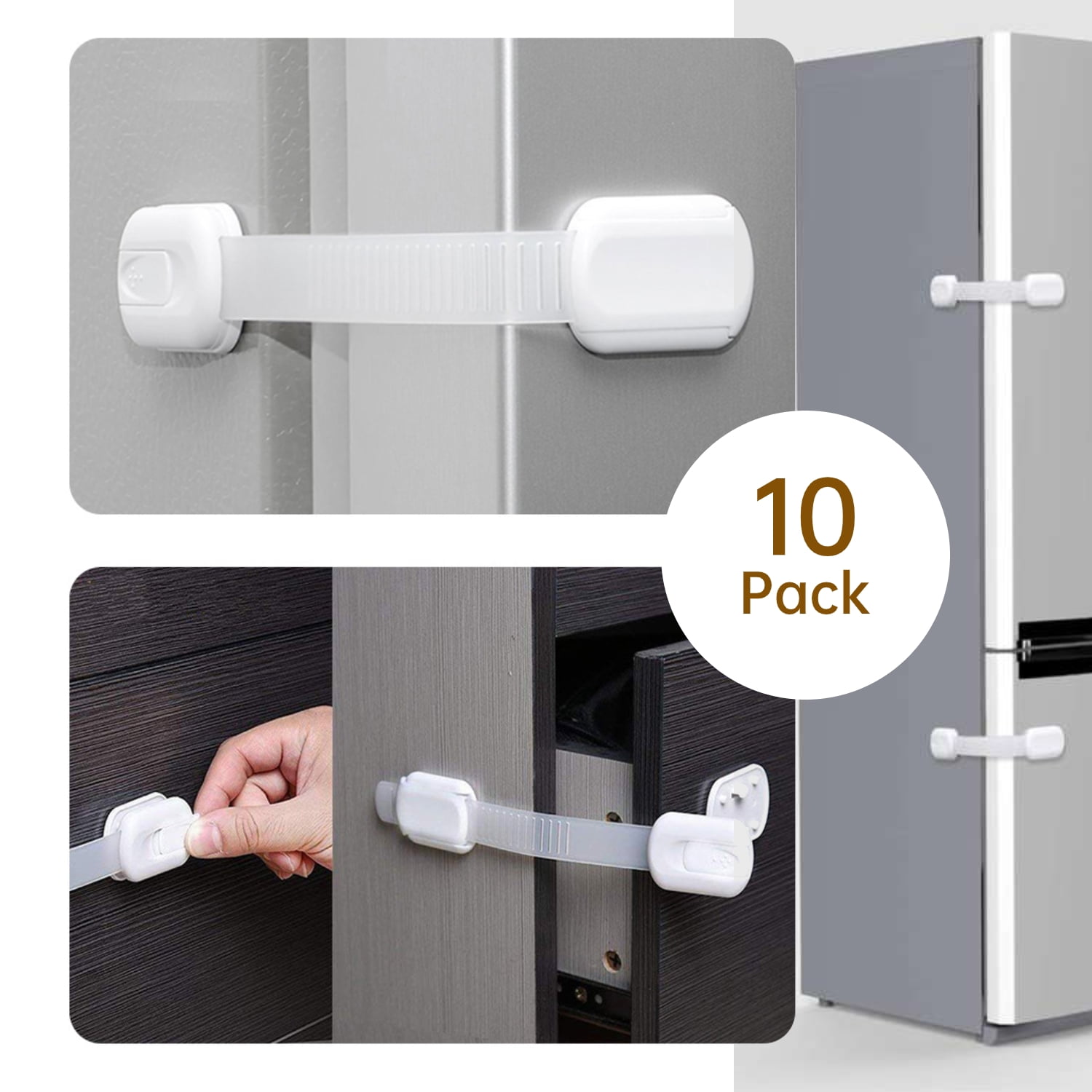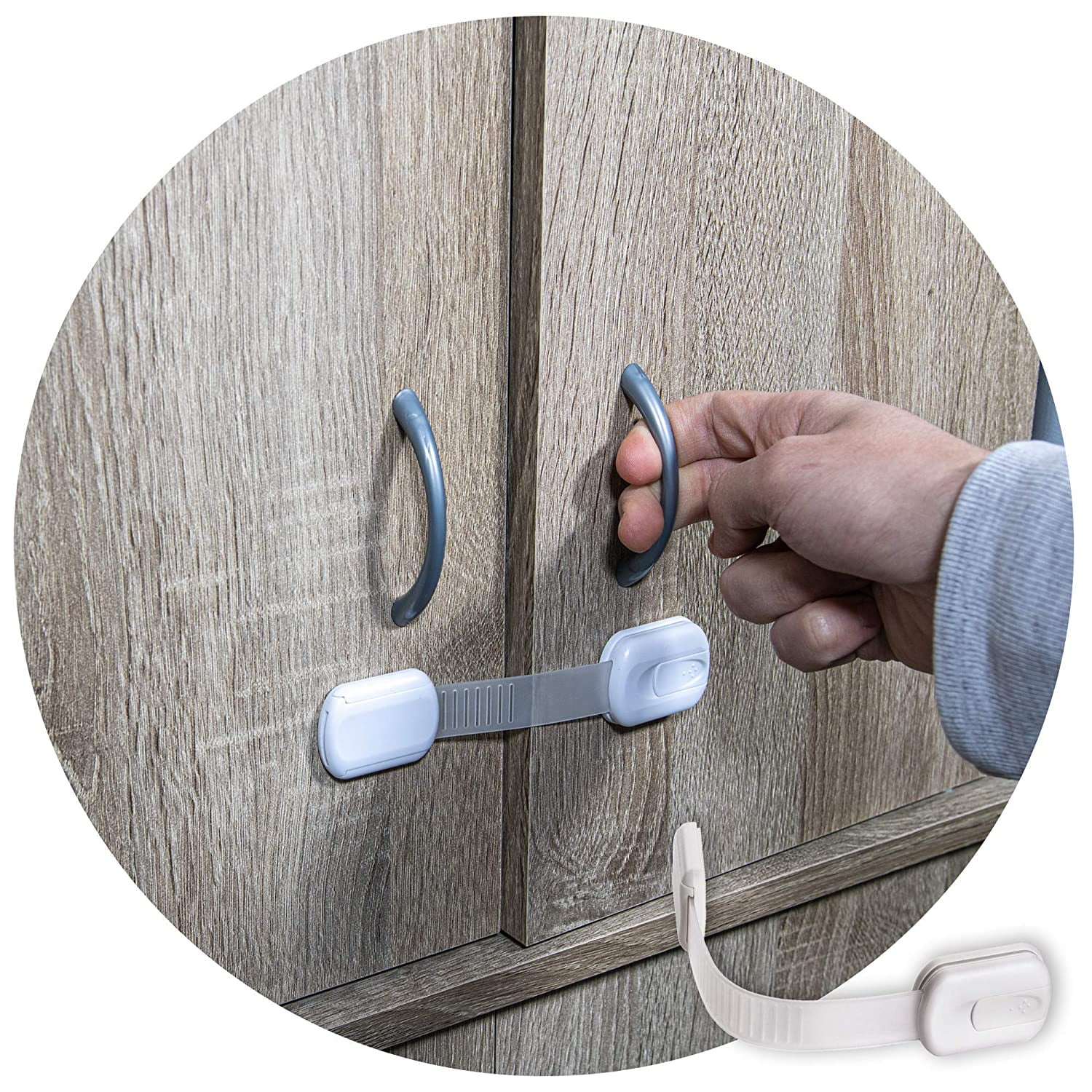Types of Cabinet Door Safety Latches

Protecting children from potential hazards within the home is paramount, and securing access to potentially dangerous contents within cabinets is a key aspect of this. A variety of safety latches are available, each offering distinct advantages and disadvantages based on their mechanism, material, and ease of use. Choosing the right latch depends on factors such as the cabinet’s design, the age and dexterity of the child, and the desired level of security.
Magnetic Latches
Magnetic latches utilize the attractive force between magnets to secure cabinet doors. One magnet is embedded in the cabinet door, while the other is affixed to the cabinet frame. The magnets hold the door closed, preventing accidental opening. These latches are typically made of plastic or metal, offering varying degrees of strength and aesthetic appeal. Installation is generally straightforward, involving attaching the two magnet components.
| Material | Installation Method | Child-Resistance Level | Price Range |
|---|---|---|---|
| Plastic, Metal | Adhesive, Screw | Moderate | $5-$20 |
Magnetic latches offer ease of use for adults—a simple push or pull is often sufficient to open the door. However, their child-resistance level is moderate; determined children may be able to overcome the magnetic force. Durability varies depending on the material and quality of the magnets. Aesthetically, they can be unobtrusive, especially when using smaller, discreet magnets.
Latch and Loop Latches
Latch and loop latches consist of a small latch that engages with a loop or hook on the cabinet frame. These are often made of metal or plastic and are installed by screwing or adhering them to the cabinet door and frame. The latch mechanism provides a more secure closure than magnetic latches, offering a higher level of child resistance.
| Material | Installation Method | Child-Resistance Level | Price Range |
|---|---|---|---|
| Metal, Plastic | Screw, Adhesive | High | $10-$30 |
Adults can easily operate latch and loop latches with a simple push or turn of the latch. However, their more robust mechanism makes them more challenging for young children to open. They are generally more durable than magnetic latches and offer a greater range of styles and finishes. Installation can be slightly more complex than magnetic latches, requiring precise alignment of the latch and loop.
Push-Button Latches, Cabinet door safety latches
Push-button latches require pressing a button to release the latch mechanism, allowing the cabinet door to open. These latches are commonly made of plastic and are installed using adhesive or screws. They provide a high level of child resistance, as children generally lack the dexterity or understanding to operate the button mechanism effectively.
| Material | Installation Method | Child-Resistance Level | Price Range |
|---|---|---|---|
| Plastic | Adhesive, Screw | High | $8-$25 |
These latches are easy for adults to operate but difficult for children. The ease of installation and relatively low cost make them a popular choice. However, the plastic construction may be less durable than metal latches over time, especially with frequent use. The aesthetic appeal can vary depending on the design and color.
Combination Latches
Combination latches combine elements of different latch types, offering a high level of security and versatility. For example, a combination latch might integrate a magnetic latch with a secondary locking mechanism, such as a push-button or keyed lock. Materials and installation methods vary depending on the specific design.
| Material | Installation Method | Child-Resistance Level | Price Range |
|---|---|---|---|
| Metal, Plastic, Combination | Screw, Adhesive | Very High | $15-$40+ |
These latches provide superior child resistance but can be more complex to install and operate. The added security comes at a higher price point. The design flexibility allows for customization to match various cabinet styles and needs. Durability depends on the materials and construction quality of the individual components.
Installation and Usage of Cabinet Door Safety Latches

Securing cabinets with safety latches is a crucial step in childproofing a home. Proper installation ensures effectiveness, while understanding the mechanism allows for safe and efficient usage. This section details the installation and usage of various latch types, providing clear instructions and practical tips for optimal performance.
Magnetic Latches: Installation and Usage
Magnetic latches offer a simple, quiet, and relatively easy installation solution. Their ease of use makes them popular for low-traffic cabinets.
- Step 1: Positioning the Latch Components: Carefully align the magnetic receiver plate to the inside of the cabinet door, ensuring it’s flush against the surface. Mark the screw holes with a pencil.
- Step 2: Securing the Receiver Plate: Using a screwdriver, attach the receiver plate to the cabinet door using the provided screws. Ensure the screws are tightened securely but not over-tightened to avoid damage.
- Step 3: Attaching the Magnet: Align the magnet to the cabinet frame, ensuring it’s positioned to engage with the receiver plate when the door is closed. Mark the screw holes and attach the magnet securely using the provided screws.
- Step 4: Testing the Latch: Close the cabinet door to test the latch mechanism. The magnet should firmly hold the door closed. Adjust the position of the magnet or receiver plate if necessary.
Cabinet door safety latches – Visual Guide: Imagine a simple illustration. The cabinet door is shown closed. A small, round magnet is visible on the cabinet frame, directly opposite a small, rectangular metal plate recessed into the cabinet door. The magnetic force holds the door closed. To open, simply pull the door open against the magnetic force.
Latch with a Buckle and Strap: Installation and Usage
These latches offer a more robust solution, particularly for heavier cabinet doors. They typically involve a strap and buckle mechanism.
- Step 1: Drilling Pilot Holes: Carefully mark the locations for the screws on both the cabinet door and frame. Drill pilot holes to prevent wood splitting.
- Step 2: Attaching the Buckle: Secure the buckle component to the inside of the cabinet door using the provided screws.
- Step 3: Attaching the Strap: Attach the strap to the cabinet frame, ensuring it aligns correctly with the buckle. Again, use the provided screws.
- Step 4: Securing the Strap: Tighten the screws on both the buckle and strap, ensuring a secure connection. Test the latching mechanism.
Visual Guide: The illustration would show a cabinet door with a metal buckle attached to its inside. A fabric or plastic strap extends from the buckle to a metal clasp affixed to the cabinet frame. To secure, the strap is pulled through the buckle and fastened. To unlock, the strap is released from the buckle.
Push-Button Latches: Installation and Usage
These latches are operated by pushing a button, releasing the locking mechanism.
- Step 1: Marking and Drilling: Mark the positions for the latch mechanism on the cabinet door and frame. Drill the necessary holes, if required, using the correct drill bit size.
- Step 2: Attaching the Latch Components: Attach the latch components to the cabinet door and frame, using the provided screws. Ensure that the latch components align correctly for proper functionality.
- Step 3: Testing the Mechanism: Close the cabinet door and test the push-button mechanism. The latch should securely lock and unlock with a simple push of the button.
Visual Guide: The image depicts a small, recessed button on the cabinet door’s edge. Pressing the button releases the latch, allowing the door to open. A small mechanism is visible within the door frame, engaged with the button when the door is closed.
Practical Tips and Maintenance
Always use the appropriate screws and drill bits for the type of wood and latch being installed. Regularly inspect the latches for wear and tear, tightening loose screws as needed. Lubricate moving parts periodically to ensure smooth operation. For particularly heavy doors, consider using stronger latches or adding additional support. Replacing worn-out latches promptly ensures continued safety.
Safety Considerations and Best Practices

Cabinet door safety latches are not merely convenient additions to a home; they are critical safety devices, especially in households with young children. Their proper selection, installation, and use significantly mitigate the risk of serious accidents involving hazardous materials or potentially harmful objects stored within cabinets. Neglecting this crucial aspect of childproofing can have severe consequences.
The importance of using these latches cannot be overstated. They provide a crucial barrier between curious children and potential dangers, such as cleaning supplies, medications, or sharp utensils. A seemingly innocuous cabinet can become a source of significant injury or even poisoning without the added protection of safety latches.
Hazards of Improper Installation or Malfunctioning Latches
Improperly installed or malfunctioning cabinet latches present a range of hazards. A poorly fitted latch may fail to secure the cabinet door, leaving children with easy access to dangerous contents. Conversely, a latch that is too difficult to operate for adults may lead to frustration and potentially result in the latch being bypassed or removed entirely, negating its intended safety function. Furthermore, faulty latches may break unexpectedly, again leaving cabinets unsecured. Such failures can lead to accidents ranging from minor injuries to severe poisoning or ingestion of harmful substances. In some cases, a child might even become trapped inside a cabinet due to a malfunctioning latch.
Best Practices for Selecting and Using Cabinet Door Safety Latches
Selecting and using cabinet door safety latches effectively requires careful consideration. The following best practices emphasize both child safety and ease of adult access.
- Choose robust and reliable latches: Opt for latches made from durable materials that are resistant to tampering and show minimal wear and tear from repeated use. Consider latches with a strong locking mechanism and a design that is difficult for children to manipulate.
- Prioritize ease of adult operation: While child-resistance is paramount, the latch should be easily opened by adults without requiring excessive force or complex maneuvers. A latch that is too difficult to use may lead to its neglect.
- Install latches on all relevant cabinets: Do not limit the use of safety latches to only cabinets containing obviously hazardous materials. Children are inherently curious and may explore cabinets containing seemingly innocuous items that could still pose a risk if ingested or mishandled. This includes cabinets containing medications, cleaning supplies, sharp objects, and even certain foods.
- Regularly inspect and maintain latches: Periodically check the latches for signs of wear, damage, or loosening. Replace any latches that show signs of malfunction or damage to ensure continued effectiveness. Regular inspection can prevent unexpected failures and maintain the safety provided by the latches.
- Educate household members: Ensure all household members understand the importance of using the cabinet latches and how to properly operate them. This includes both adults and older children who may be capable of understanding the need for such safety measures.
